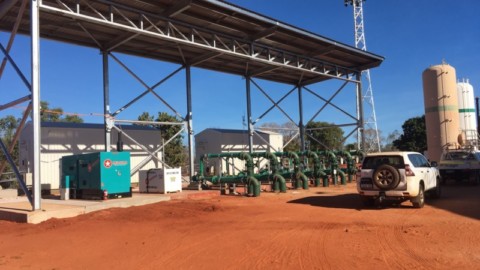The Southern Forests region around Manjimup and Pemberton is one of Western Australia’s most significant horticultural regions, however climate change is expected to limit water availability in future years under current water management practices. Therefore, to support the sustainability and expansion of the region, the Southern Forests Irrigation Scheme (SFIS) will provide a new, innovative way to secure reliable, good quality water supply all year round by improving water storage and distribution through a new dam, pipeline and pumping infrastructure. Pump Industry magazine sat down with Jeremy Bower, Chief Executive Officer of the SF Irrigation Co-operative, to find out more about the design of the project.
The Manjimup-Pemberton area of Western Australia is one of the state’s prime food hubs and the largest economic contributor from irrigated agriculture.
However, it is predicted that this area will be one of the hardest hit by climate change, with models predicting rainfall could decline up to 20-25 per cent in coming decades – with reduced rainfall already being experienced.
The effects of this have been further exacerbated with the closure of a number of sub-catchments due to full water allocation in the region since 2012 by the Department of Water.
Currently, farmers self-supply their water in on-stream and on-property dams to capture and store water for irrigation during summer.
However, rainfall and inflow to dams is highly variable in some areas with poor water quality sometimes occurring at the end of the irrigation season.
Furthermore, the inability to capture water without an adequate dam site in various locations has constrained the growth of the irrigation industry in the region.
This current system of water capture also lacks the infrastructure to share this precious resource and put it to its most productive use.
In order to drought-proof the region’s horticultural water supply and to expand the potential as a supplier of quality fruit and vegetable to domestic and international markets, the SFIS is being developed by the SF Irrigation Co-operative Limited (SFIC) in partnership with the State Government.
The SFIS was originally proposed under the previous State Government’s Water for Food program and offers the opportunity to supply water in a model that fits with the National Water Initiative and to stimulate economic investment.
Oversight of the scheme moved to the Department of Primary Industries and Regional Development (DPIRD) under the current Labor Government, and then in June 2017 the SFIC was established to lead the project development and will own and operate it once completed.
The scheme received funding from the State Government, from the Federal Government’s National Water Infrastructure Development Fund, and from local growers via the first round of water sales.
Designing the SFIS: taking inspiration from Tasmania
The most common method for water management in agricultural regions in Western Australia is the use of on-stream or gully dams for farms, but the State Government wanted a more sustainable method that would protect the region’s agricultural industry, as well as the environment.
In 2015-16, various options were assessed including building bigger dams in some of the sub-catchments and approaching farmers to sell their excess water to those dams.
However, these options proved to be unviable. Jeremy Bower, Chief Executive Officer of the SFIC, said this led to the WA Government taking inspiration from a solution in Tasmania.
“Tasmania has now built 15 irrigation schemes where a major water source, such as a river, has been linked to a pipe network to deliver water to farms in certain districts.
These schemes have been very successful in terms of increasing productivity and being sustainable.
Tasmanian Irrigation assisted the WA State Government in assessing the potential for a scheme in the Southern Forests region including completing a business case that clearly demonstrated that the region could support a similar scheme and would bring significant economic benefit to the south-west,” Mr Bower said.
“Over the past three years, there’s been extensive environmental surveys, catchment modelling and monitoring, and environmental flow studies to ensure first and foremost that the environment is not adversely affected by the scheme now and into the future.”
The SFIS takes into account the unique requirements and environment of the region, with a reservoir to be constructed approximately 3km away from the river source.
Studies were completed for the location of the reservoir and pipe network, and expressions of interest for water purchase were sent to the local farming community to ascertain the water demand and the likely scale of the scheme.
Originally, the demand was over 11 gigalitres (GL) of water, however this was subsequently reduced to 9.3GL by the Department of Water to reduce cost.
Following this, reliability studies were done to ensure the capability of the scheme to be sustainable over dry periods.
“The end result was a 15GL dam and approximately 250km of pipeline to over 90 farms thus far. We have approximately 1.7GL of water available for future sale, which if sold, would create a scheme that delivers water to over 100 farms in the district,” Mr Bower said.
Mr Bower said there have been some concerns around water trading but that the rules and system being implemented for the SFIS does not permit water investors’ or speculators’ involvement.
“You must be a member of the SFIC to participate in this scheme and to become a member you must be a landholder (lessee) and/or own a farm in the scheme district, with appropriate plans for agricultural use,” Mr Bower said.
“It’s taken time for certain stakeholders to understand, but being able to pipe water between properties is actually one of the most sustainable parts of a water scheme.
If farmer A doesn’t require all his water allocation for his business for one year or even over a certain number of years, instead of that water sitting in an on-stream dam, or being lost out of the system, he could reduce costs and sell the water to a neighbour for agricultural use.
This method ensures water is always put to its highest productive use and not wasted. “It’s not about making money trading water, it’s recognising that water is becoming an increasingly scarce resource and we need to get smarter about how we manage it.
It’s about providing the most efficient system to ensure the provision of good quality, reliable water for a really important Western Australian food producing region.”

The pumps that will bring water to the farms
The proposed water supply system for the SFIS has been modified based on feedback from community and key stakeholders by changing the design to minimise direct impact on the river and its riparian vegetation.
For example, the headworks have been re-designed to use submersible pumps adjacent to a deep pool created by a natural rock bar instead of constructing a man-made weir across the river, which would have created a large inundation area flooding vegetation.
In addition, the pump stations have been separated to reduce the footprint at the river by around 80 per cent.
The harvest pump site at the river will utilise a set of five to seven submersible pumps housed within a discrete concrete wet-well capable of pumping up to 200ML per day.
These pumps will be connected to a 3ML balance tank at a boost pump station located approximately 100m from the river in a sound-proof shed.
The water will then be pumped via a set of seven to nine variable speed drive end suction pumps through a 3km pipeline to the 15GL reservoir in the Record Brook gully.
At the dam, a distribution pump set containing eight horizontal variable speed drive pumps will be installed, which will move water to header tanks located at the highest points through separate northern and southern delivery lines.
The water will then be gravity fed through an approximately 250km pipeline network to the SFIC farmers.
Mr Bower said the proposed system requires significant pumping infrastructure as the scheme will only abstract water from the river during large flows predominantly through the winter months and only when the minimum flow threshold (set by the Department of Water and Environmental Regulation (DWER)) has been exceeded.
It is important that these rates of extraction can be achieved to ensure that water is only extracted within permitted river flow criteria so that environmental flow is not impacted.
“Submersible pumps have been utilised in Tasmanian schemes and have clearly demonstrated their low environmental impact and their water harvest capability when high river flow rates occur during narrow seasonal windows,” Mr Bower said.
“This new design, with the submersibles and using a natural rock bar to provide adequate suction depth really reduces our footprint, as well as noise and visual impact.”
The SFIC has worked closely with river ecologists from DWER, as well as independent scientists and expert panels to ensure the minimum flow restrictions before pumping are correct and to ensure the river ecosystem is maintained.
Monitoring stream flow
In order to adhere to the strict pumping controls and to accurately measure and record stream flow for pump station control, the SFIS is investigating options for state-of-the-art monitoring equipment.
Mr Bower said the investigation is in the early stages, but the chosen equipment will have the level of accuracy required by DWER and is a condition of the water abstraction licence.
“We’ll be guided by DWER on what is needed and where it is required. DWER have monitoring stations that may be utilised.
“There is technology available that can provide a high level of accuracy and we will decide this through the detailed design process.”

Finalising the design and the tender process
Working with farmers has been important throughout the design process, with the design and pipe network ultimately controlled by their requirements and their knowledge of the region.
“We are currently working with local landholders along the proposed construction corridor to finalise the alignment for the infrastructure.
Farmers’ local knowledge has been utilised to complete the design. Knowing where there’s a high point or a low point or a wet spot or something that is better to avoid is invaluable,” Mr Bower said.
Before the COVID-19 restrictions, the SFIC team was visiting landholders to ground-truth the alignment of the pipeline with farmers.
However, consultations are now online until in-person visits recommence, but despite this change, Mr Bower said the new process is working well.
“We’ve got alignment maps drawn up and we’re sending those by email. Farmers are marking them up and we’ll ground-truth them when restrictions are lifted,” Mr Bower said.
Along with community consultations, other preliminary work is being done including completing preliminary design of the dam and second stage geotechnical work.
Earlier this year, DPIRD tendered and awarded a contract to complete these works.
Mr Bower said the SFIC planned to have these field investigations completed before the start of winter, but COVID-19 impacts on intrastate travel has impacted the schedule.
However, if these field and design tasks can be completed in the expected time frame, the SFIC is anticipating releasing tender documents early in the first quarter of 2021.
Mr Bower said two main tenders are expected to be advertised, with the project being run as design and construct contracts.
“We’re providing preliminary designs to reduce tender costs to enable more Tier 2 and 3 contractors to get involved.
Once the contracts are awarded, we’ll need to see a completed design which complies with best practice,” Mr Bower said.
The project works will be split into two D&C contracts, with the dam works separate to the pumps and pipelines.
The SFIC is currently looking at the various tender requirements, including the desired performance and duty cycles, but this process is subject to approvals and environmental reviews confirming sustainability of the scheme.
Mr Bower said ideally the SFIC will engage local suppliers and contractors, or those based in Western Australia.
However, the two head contractors will need Federal Safety Accreditation, so key suppliers will need to engage with those tendering for the work and to be part of the bid teams.
The names of companies tendering for the work will be posted on the SFIC website so suppliers and subcontractors know who to approach.
Ultimately, the contracts will be awarded to companies that can demonstrate they can complete works that will deliver the water and operate the scheme most efficiently.
Once the head contractors are selected, notification will be posted on the website.
For more information about the Southern Forests Irrigation Scheme and to keep up to date with the project, visit http://sfirrigationcooperative.com.au/.

















